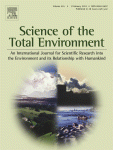Science of The Total Environment 438
Overview of articles on POPs in a new issue of the Science of The Total Environment journal.

Pages 33-41
Tian Lu, Zhen Huang, C.S. Cheung, Jing Ma
- Size-resolved diesel particles were collected and analyzed for EC, OC and PAHs.
- The reduction effect of biodiesel concentrated on EC emission in large size range.
- Biodiesel could reduce PAHs emission, especial for heavy PAHs in small size range.
- Biodiesel could reduce the carcinogenic potency of PAHs in all the size ranges.
Pages 166-173
Ulrika Nordlöf, Björn Helander, Yngve Zebühr, Anders Bignert, Lillemor Asplund
- PCDD/Fs levels in white-tailed sea eagle (WTSE) eggs from the Baltic Sea and Greenland.
- 2,3,4,7,8-PCDF was the predominant congener in all areas.
- The total toxic equivalents (TEQ) in the WTSE were higher than reported in eggs for many other birds.
- The major contributors to the TEQ in the Baltic Sea were the non-ortho-PCBs.
Pages 527-532
Stacy S. Vander Pol, Daniel W. Anderson, Patrick G.R. Jodice, Joyce E. Stuckey
- This was the first known analysis of BDEs in the Gulf of California (GofCA).
- Brown pelicans in southeast U.S. (SC) and GofCA have different population trends.
- GofCA eggs had higher levels of lower brominated BDEs than SC; patterns also varied.
- PCBs, chlordanes, dieldrin and mirex were greater in SC eggs; DDTs and HCHs were lower.
29.10.2012




